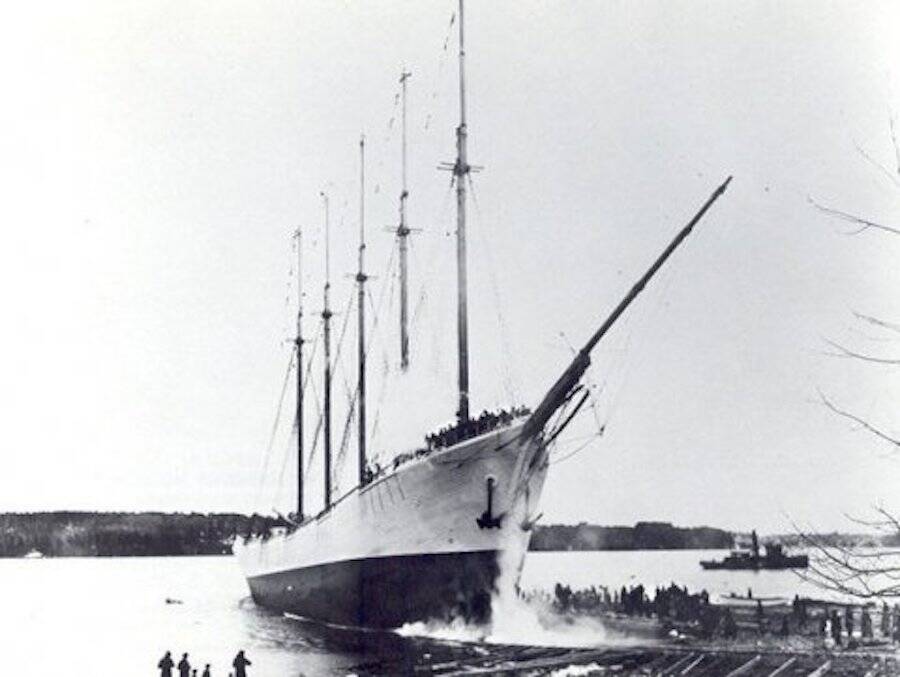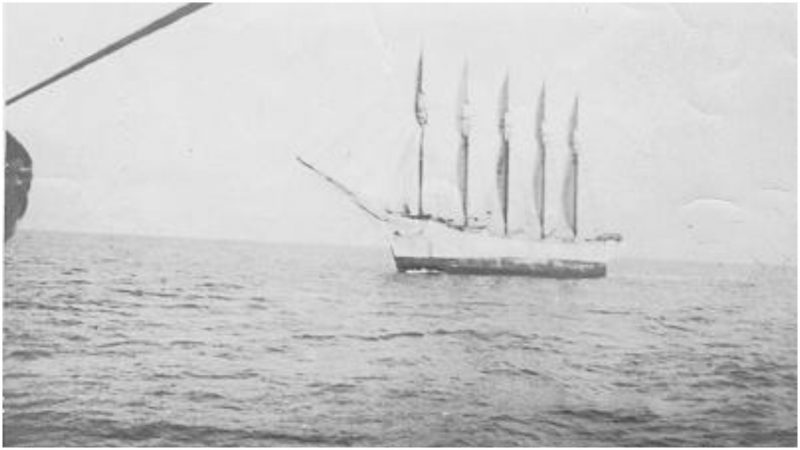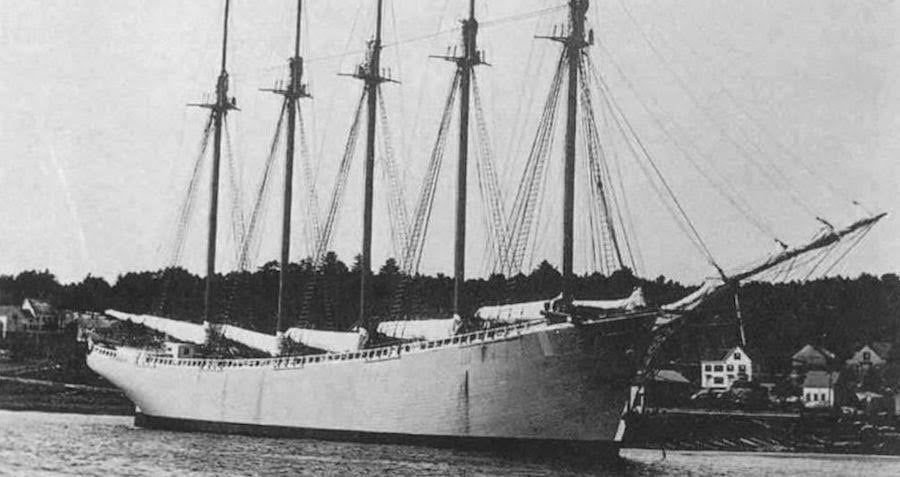
The Eerie Enigma of the Carroll A. Deering: A Ghost Ship’s Unsolved Mystery
In the annals of maritime history, few tales are as haunting and persistently perplexing as that of the Carroll A. Deering. A five-masted schooner, once a proud workhorse of the seas, she became an icon of the inexplicable when she was discovered on January 31, 1921, off the treacherous Diamond Shoals of North Carolina – utterly deserted, yet seemingly unharmed. Her crew, all eleven souls, had vanished without a trace, leaving behind a riddle that has defied solution for over a century, cementing her place as one of the most famous ghost ships in history.
The story begins innocently enough. The Carroll A. Deering, built in 1919 in Bath, Maine, was a robust vessel designed for carrying bulk cargo. In late 1920, under the command of Captain W.B. Wormell, a seasoned mariner, she embarked on a routine voyage from Rio de Janeiro, Brazil, laden with a cargo of coal, bound for Portland, Maine. Aboard were Captain Wormell, his son and first mate D.W. Wormell, and a crew of nine Scandinavians. The initial leg of the journey was uneventful, but the seeds of discord, or at least unusual circumstances, may have been sown early.
According to later reports, Captain Wormell fell ill during the voyage, prompting a stop in Barbados for medical attention. While there, the captain allegedly had a heated argument with his first mate, D.W. Wormell, leading to the latter’s temporary arrest. Though the dispute was resolved and the journey resumed, this incident provided early fodder for theories of mutiny. There were also whispers of a new, rather sullen crew member taken on in Barbados, further complicating the ship’s internal dynamics.

The last confirmed sighting of the Carroll A. Deering with her crew aboard occurred on January 29, 1921. She was spotted by the Cape Lookout lightship keeper, who reported a man with red hair, believed to be Captain Wormell, hailing the lightship and reporting that the schooner had lost her anchors. The lightship keeper noted that the crew seemed to be "milling around" in an unusual manner on the deck, a detail that would later fuel much speculation. The Deering continued north, sailing into the notorious waters of the Outer Banks, a stretch of coastline infamous as the "Graveyard of the Atlantic."
Two days later, on January 31, 1921, the spectral presence of the Carroll A. Deering was confirmed. The Coast Guard schooner USS Roamer, on patrol, spotted the five-masted vessel aground on the outer edge of Diamond Shoals, a shifting, submerged sandbar that has claimed countless ships over the centuries. The Deering lay listing precariously, her magnificent masts standing tall against the horizon, sails partially set, creating a chilling tableau.
What followed was a scene that has puzzled investigators and captured the public imagination for generations. Due to the dangerous weather and treacherous currents around the shoals, it took several days for a boarding party from the Coast Guard cutter USCGC Manning to reach the derelict vessel. What they found inside only deepened the mystery.
The ship was deserted. Every single member of the crew was gone. There were no signs of a struggle, no bloodstains, no bullet holes. The ship’s navigational equipment, including the chronometer and sextant, was missing. Crucially, the ship’s logbook, which would have contained a record of the final days and any critical events, was also gone. The lifeboats, usually stowed on deck, were nowhere to be found. Yet, in other respects, the ship seemed strangely intact. A meal was reportedly laid out in the galley, and there were signs that the crew had been preparing to eat. In one account, a lamp was found still burning, and a pot of coffee was on the stove, though these details may have been exaggerated in later retellings to heighten the eerie atmosphere.
The lack of a distress call, the absence of the crew and lifeboats, and the missing logbook immediately pointed to an intentional abandonment, but under what circumstances? The Deering herself was not significantly damaged. Her hull was intact, and while she had run aground, it was clear that this was not the primary cause of the crew’s disappearance. The initial investigation, led by the U.S. Department of Commerce and the Coast Guard, was exhaustive, but ultimately inconclusive. They explored every conceivable theory, each one presenting its own set of unanswered questions.
Theories and Speculations:
-

Mutiny: The early reports of discord between Captain Wormell and his first mate in Barbados, coupled with the alleged "milling around" of the crew seen from the Cape Lookout lightship, lent credence to the mutiny theory. Perhaps the crew, discontented with the captain’s strictness or driven by some other grievance, had seized control of the ship, forced the officers into a lifeboat, and then vanished themselves. However, if they had mutinied, why abandon the perfectly good ship? And why leave it in such an orderly, albeit deserted, state? Why take the logbook and navigational tools but leave the cargo of coal untouched?
-
Piracy: The early 20th century, though past the golden age of piracy, still saw instances of maritime crime, particularly in certain regions. The Caribbean, where the Deering had recently been, was not entirely free of such threats. The idea that pirates boarded the Deering, murdered or kidnapped the crew, and then left the ship to drift, gained some traction. However, this theory also had significant holes. The ship’s valuable cargo of coal was untouched. There were no signs of forced entry or a violent struggle. Pirates typically sought plunder, and the Deering, while not a treasure ship, surely contained items of value beyond her cargo that would have been taken.
-
Storm and Abandonment: The Outer Banks are notorious for sudden, violent storms and rogue waves. It was plausible that the Deering encountered a severe gale, forcing the crew to abandon ship in haste. They might have taken to the lifeboats, only to be overwhelmed by the tempestuous seas. This theory could explain the missing lifeboats and the absence of the crew. However, it doesn’t fully account for the ship’s relatively undamaged state. While a vessel can survive a storm that overwhelms its crew in lifeboats, the lack of extensive damage to the Deering itself, combined with the systematic removal of the logbook and navigational instruments, suggests a more deliberate, if desperate, act than a simple, panicked abandonment.
-
Paranormal or Supernatural Intervention: Given the lack of any rational explanation, the Carroll A. Deering quickly became synonymous with the supernatural. The term "ghost ship" became inextricably linked to her story. For many, the idea of a ship sailing silently, fully rigged, yet utterly devoid of human life, points to forces beyond human comprehension. The "Graveyard of the Atlantic" is fertile ground for such legends, and the Deering’s tale fit perfectly into the lore of the sea’s insatiable hunger for souls.
-
Conspiracy Theory – The Rum-Running Connection: A more sensational theory that emerged years later connected the Deering’s disappearance to the Prohibition era in the United States. It was suggested that the Deering might have been involved in rum-running. The theory posited that the crew might have been involved in an illicit operation, perhaps transferring their cargo or engaging in a rendezvous, and then were either double-crossed, captured, or deliberately vanished to avoid detection. The missing logbook could have been a deliberate act to destroy evidence. While intriguing, there was never any concrete evidence to support this claim, and the ship’s cargo of coal made her an unlikely candidate for a rum-runner.
The Legacy of the Mystery:
Despite extensive inquiries and a formal investigation, the official conclusion was "cause unknown." The Carroll A. Deering herself became an additional victim of the Diamond Shoals. After days of being battered by the waves, and deemed a navigational hazard, she was eventually dynamited by the Coast Guard on March 4, 1921, to prevent further damage to shipping. Her broken timbers scattered across the sands, a final, silent testament to her unresolved fate.
The mystery of the Carroll A. Deering resonated deeply with the public. It occurred at a time when the world was grappling with the aftermath of World War I and the Spanish Flu pandemic, creating a fertile ground for stories of the unexplained. The image of a majestic schooner sailing aimlessly, a perfect vessel without a soul, touched a primal fear of the unknown.
For maritime historians and enthusiasts, the Deering remains a fascinating cold case. Her story is often compared to that of the Mary Celeste, another famous ghost ship found abandoned in the Atlantic in 1872, though the circumstances of the Deering’s discovery were arguably even more perplexing due to the utter lack of any explanation for the crew’s departure.
The Carroll A. Deering serves as a powerful reminder of the immense, untamed power of the ocean and the inherent vulnerabilities of those who traverse it. She embodies the enduring allure of maritime mysteries, tales that challenge our understanding and force us to confront the limits of our knowledge. Was it a mutiny born of simmering tensions? A brutal act of piracy left undiscovered? A catastrophic encounter with a rogue wave or an unseen peril that swept all hands away? Or something far more unfathomable, a whisper of the supernatural carried on the wind?
Nearly a century later, the Carroll A. Deering remains a riddle wrapped in an enigma, a phantom vessel whose sails caught the wind of legend. Her story continues to be told and retold, each recounting adding another layer to the spectral tapestry of the sea’s unsolved mysteries, ensuring that the eerie enigma of the Carroll A. Deering will forever drift in the currents of our collective imagination.


